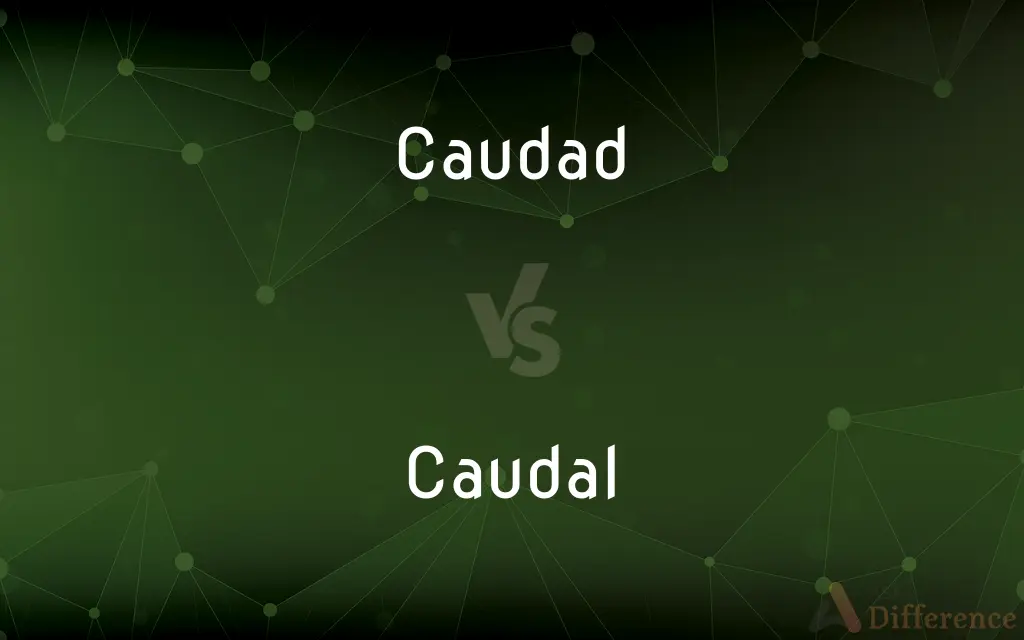Caudad vs. Caudal — What's the Difference?
By Maham Liaqat & Urooj Arif — Updated on April 26, 2024
Caudad is primarily a directional term in medicine, meaning towards the tail or posterior, while caudal, often used interchangeably, more frequently appears in anatomy to describe positions or structures in relation to the tail end.

Difference Between Caudad and Caudal
Table of Contents
ADVERTISEMENT
Key Differences
Caudad is a directional term used in medicine and biology to indicate movement or orientation toward the tail or posterior end of the body. In contrast, caudal is often used to describe the position of an anatomical structure as being at or near the tail end of the body.
In clinical contexts, when a procedure involves movement towards the lower end of the body, the term caudad might be employed. Caudal, on the other hand, is typically used to specify the location of an anatomical feature in relation to the body's overall structure, like caudal fin in fishes.
Caudad can be used in instructions or descriptions involving the relative movement in vertebrates, indicating a direction opposite to that of the head. Whereas caudal may be applied more statically, to describe features that permanently reside near the tail end of an organism.
The usage of caudad is less common and more specific in its application to movement or directional shifts. Caudal is broader and more frequently encountered in both medical texts and general anatomical references.
In terms of etymology, both terms originate from the Latin word "cauda," meaning tail. However, caudad often carries a more dynamic implication suitable for procedural descriptions in medicine, while caudal is used more broadly in descriptions of anatomical orientation.
ADVERTISEMENT
Comparison Chart
Usage
Directional, indicating movement
Positional, describing location
Common Contexts
Medical procedures
Anatomy, zoology
Orientation
Toward the tail end
At or near the tail end
Frequency of Use
Less common
More common
Etymological Root
Latin "cauda" (tail)
Latin "cauda" (tail)
Compare with Definitions
Caudad
Toward the posterior or tail end.
The surgeon instructed to make an incision moving caudad from the initial point.
Caudal
Relating to the tail end.
The caudal artery supplies blood to the posterior region of the body.
Caudad
Directed backward or toward the tail.
The nerve runs caudad along the spine.
Caudal
Used to describe features positioned at the back of an anatomical layout.
Look at the caudal appendages for identifying the species.
Caudad
Pertaining to movement in the direction of the tail.
Adjust the microscope slide caudad to view the sample's posterior.
Caudal
Located at or near the tail end of the body.
The caudal fin of the shark provides propulsion.
Caudad
In a declining or downward direction in vertebrates.
The medication is injected and then moves caudad within the tissue.
Caudal
Pertaining to the tail or posterior part of an organism.
Caudal vertebrae are towards the end of the vertebral column.
Caudad
Referring to the rear or tailward part.
During the dissection, focus on the caudad portion of the specimen.
Caudal
Anatomically towards the back or tail of a structure.
In human anatomy, the caudal direction is often towards the feet.
Caudad
Toward the tail or posterior end of the body; caudally.
Caudal
Of, at, or near the tail or hind parts; posterior
The caudal fin of a fish.
Caudad
(zoology) backwards; toward the tail or posterior part
Caudal
Situated beneath or on the underside; inferior.
Caudad
(anatomy) towards the feet (only in humans); inferior.
Caudal
Similar to a tail in form or function.
Caudad
Backwards; toward the tail or posterior part.
Caudal
(zoology) Pertaining to the tail or posterior or hind part of a body.
Caudal
Toward the tail end (hind end) of the body; in bipeds such as humans, this direction corresponds to inferior.
Caudal
A caudal vertebra.
Caudal
Of the nature of, or pertaining to, a tail; having a tail-like appendage.
The male widow-bird, remarkable for his caudal plumes.
Caudal
Constituting or relating to a tail;
Caudal appendage
Caudal
Resembling a tail
Caudal
(of quadrupeds) situated in or directed toward the part of the body from which the tail arises;
Caudal fins
The caudal end of the body
Caudal
Toward the posterior end of the body
Common Curiosities
Is caudal specific to vertebrates only?
While commonly used in vertebrates, caudal can also describe the tail end of invertebrates and other anatomical structures.
How is caudal used in anatomy?
Caudal is used in anatomy to describe positions or structures that are located at or near the tail end of an organism.
What type of movement does caudad describe?
Caudad describes a movement toward the tail end or the posterior part of the body.
Can caudad and caudal be used interchangeably?
While often used interchangeably, caudad is more specific to movement, and caudal is more about static location.
Are there specific animals where caudal is used more frequently?
Caudal is frequently used in descriptions of fish and other aquatic animals, where distinguishing tail features, like caudal fins, is crucial.
How does the understanding of caudad and caudal help in medical imaging?
Understanding caudad and caudal is crucial in medical imaging for correctly interpreting images and directions, particularly in scans like MRI or CT where precise anatomical orientation is required.
What does caudad mean in medical terms?
In medical terms, caudad indicates a direction or movement toward the tail or posterior part of the body.
What does the caudal region refer to?
The caudal region refers to the area at or near the tail end of an organism, which includes various anatomical structures dependent on the species.
Can the term caudal be used in both horizontal and vertical orientations?
Yes, caudal can be used to describe locations both in horizontal and vertical orientations, depending on the body plan of the organism being described.
What are common applications of the term caudad?
Caudad is commonly applied in medical procedures that involve movement toward the lower end of the body.
What is the significance of caudal in embryology?
In embryology, caudal is significant for describing the development of structures that will form the posterior or tail-end of the embryo.
Does the direction caudad have an opposite term?
Yes, the opposite of caudad is "cephalad," which means toward the head or anterior part of the body.
How does the usage of caudal differ in human anatomy compared to other animals?
In human anatomy, caudal is often used to refer to structures towards the lower body, such as the caudal vertebrae in the tailbone, whereas in other animals, it can describe entire rear sections or appendages.
Why might a veterinarian use the term caudal during a procedure?
A veterinarian might use the term caudal to describe or instruct regarding the positioning or handling of animals, particularly focusing on parts of the body near the tail, such as during surgery or examination of tail injuries.
Is caudad used in everyday language or primarily in technical contexts?
Caudad is primarily used in technical, medical, or scientific contexts and is not commonly found in everyday language.
Share Your Discovery

Previous Comparison
Leaflet vs. Pamphlet
Next Comparison
Denigrate vs. DisparageAuthor Spotlight
Written by
Maham LiaqatCo-written by
Urooj ArifUrooj is a skilled content writer at Ask Difference, known for her exceptional ability to simplify complex topics into engaging and informative content. With a passion for research and a flair for clear, concise writing, she consistently delivers articles that resonate with our diverse audience.
















































